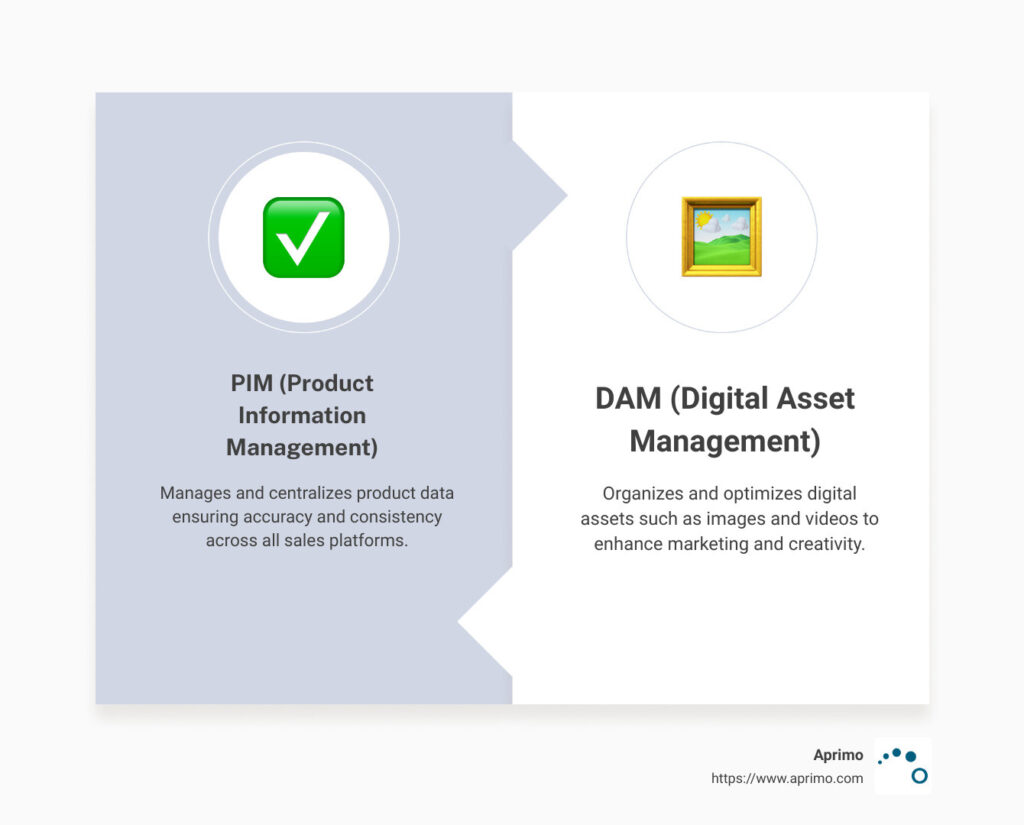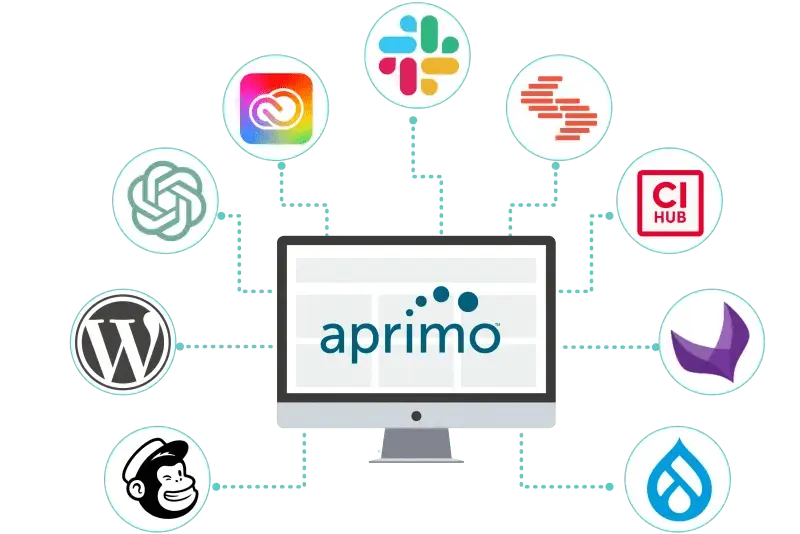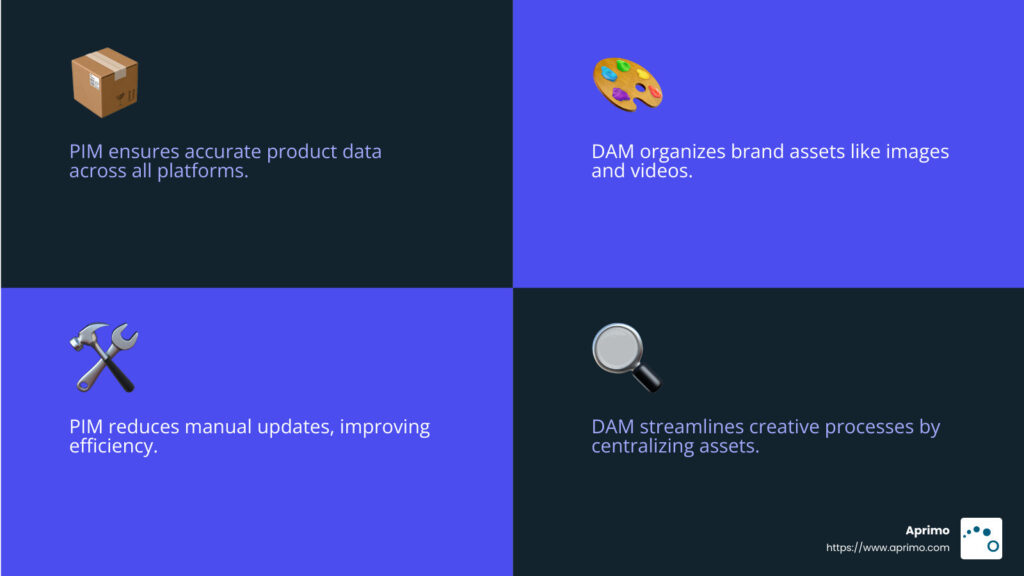Managing product information is increasingly complex. Businesses must maintain accurate, up-to-date data for thousands of products while simultaneously managing a vast array of digital assets. The challenge becomes even greater when this information needs to be distributed consistently across numerous platforms, such as websites, eCommerce marketplaces, and social media.
With manual processes prone to errors and inefficiencies, complexity often leads to data inconsistencies, delays, and a fragmented customer experience. This is where the integration of product information management (PIM) and digital asset management (DAM) becomes essential, as these systems offer a centralized solution for organizing, streamlining, and distributing both product data and digital content efficiently.
Online retailers and other businesses that manage large volumes of product data can no longer afford delays or inaccuracies. By integrating PIM and DAM, you can improve speed, flexibility, and control over both product information and digital content. The result is greater brand consistency and quicker time-to-market while fostering richer customer engagement.
Understanding PIM and DAM
PIM and DAM are changing the way businesses approach digital commerce and product experience. For companies navigating the complexities of product management, understanding these tools is crucial. Here’s a quick dive:
- PIM (Product Information Management): Manages your product data, ensuring consistency and accuracy across all sales platforms.
- DAM (Digital Asset Management): Organizes and optimizes your brand’s digital assets like images and videos, enhancing marketing efforts and creativity.
Together, they create a seamless flow of product information and media, elevating customer experience and streamlining operations.

To grasp the power of PIM and DAM, organizations must understand what each system does and how it complements the other. These tools are two sides of the same coin, each playing a vital role in managing different types of information.
What is PIM?
Product information management is all about handling product data. It ensures every detail about your products is accurate and up-to-date. PIM systems gather information like SKUs, product specifications, pricing, and descriptions. The data is then distributed across various sales and marketing platforms.
For example, a retailer juggling thousands of products across multiple e-commerce sites relies on a PIM system to ensure that all product information is consistent, whether it’s on the company website, Amazon, or any other channel. This avoids embarrassing errors like incorrect pricing or outdated product details.
What is DAM?
On the other hand, digital asset management deals with digital brand assets, including images, videos, logos, and marketing materials. DAM systems organize and optimize these assets, making them easy to find and use.
For instance, a marketing team working on a campaign needs quick access to the latest product images and promotional videos. A DAM system acts as a central hub where all these digital assets are stored and managed. It ensures brand consistency across all marketing channels and saves creative teams from the chaos of searching through scattered files.
The Harmony of Product Data and Digital Assets
By integrating PIM and DAM, businesses create a unified system where product data and digital assets work together seamlessly. Integration streamlines operations and improves the customer journey. When a potential buyer sees a product online, they get a complete and consistent experience—from detailed product information to high-quality images and videos.
Leveraging both PIM and DAM systems is essential and offers several benefits. They empower businesses to maintain accuracy, improve brand consistency, and deliver a richer, more engaging customer experience.

Key Differences Between PIM and DAM
Understanding PIM and DAM’s distinct roles can help streamline business operations and improve your brand’s efficiency.
Product Information vs. Brand Assets
PIM and DAM are two distinct systems that serve different yet complementary purposes in managing business content. At the core, PIM focuses on handling product information. It’s the go-to system for organizing and distributing product-related information, such as specifications, descriptions, pricing, and technical data. It ensures that accurate and consistent product information is available across various sales and marketing channels, including websites, catalogs, and point-of-sale systems.
DAM is all about brand assets. It manages essential assets for maintaining brand consistency, often used by marketing teams to create compelling campaigns. DAM ensures that these assets are stored, organized, and accessible for use in marketing, advertising, or communication efforts.
For a fashion retailer, the distinction between PIM and DAM becomes very clear. In the PIM system, the retailer would store product-specific details like fabric type, sizing information, care instructions, and pricing for each item of clothing. This data is essential for listing products on eCommerce platforms, creating product catalogs, and ensuring accurate information across all sales channels.
On the other hand, the DAM system would store the visual elements related to the brand, such as photoshoots, product videos, lookbooks, logos, and promotional content. These assets are used for marketing campaigns, social media posts, and advertisements, ensuring that the brand’s visual identity remains consistent and on point.
For example, when the fashion retailer launches a new line of winter coats, the PIM system would ensure that each coat’s product description, size availability, material details, and pricing are accurately distributed to its website, mobile app, and retail partners. Meanwhile, the DAM system would handle the high-quality images from the winter coat photoshoot, ensuring that the same visuals are used across marketing campaigns, social media ads, and store displays.
The PIM provides the vital product information needed for transactions, while the DAM provides the branded assets needed to create a consistent and compelling visual experience.
While PIM and DAM are distinct in their focus—product information versus brand assets—both are essential for ensuring that businesses present a cohesive and accurate message. Both systems work together to deliver a seamless shopping experience, combining detailed product information with strong, consistent brand visuals.
Operational Efficiency
Both systems contribute to operational efficiency but in different ways.
- PIM systems improve efficiency by centralizing and streamlining the management of product data, ensuring consistent and accurate information across all sales channels, reducing manual updates, and minimizing errors.
- DAM systems improve efficiency by providing quick access to organized, approved brand assets. They enable teams to easily locate, distribute, and reuse digital content for marketing and communication efforts without duplicating work.

The Impact on Business Operations
By leveraging both PIM and DAM, businesses can create a centralized hub where product data and brand assets work together. Integration boosts operational efficiency and improves the customer experience.
For instance, when a potential customer views a product online, they see accurate details and high-quality images, creating a seamless and engaging journey. Visibility is crucial in today’s digital-first marketplace, where customer expectations are higher than ever.
Benefits of Integrating PIM and DAM
Integrating PIM and DAM can boost your business in several key areas.
Faster Time-to-Market
Integrating PIM and DAM accelerates time-to-market by enabling organizations to seamlessly manage both product data and digital assets in one streamlined workflow. When product information is directly linked to relevant digital assets, marketing teams can quickly create and deploy product listings across multiple channels.
The integration reduces the time spent manually searching for assets or verifying product details, allowing teams to publish accurate, media-rich content faster and more efficiently.
By eliminating silos between product and brand data, organizations can ensure that product launches, updates, and campaigns are executed smoothly and without delays. With a combined PIM and DAM system, businesses can easily manage complex product portfolios, ensuring that every piece of content—from product descriptions to high-quality visuals—is consistent and synchronized across all platforms.
A cohesive approach shortens the review and approval processes, allowing brands to respond faster to market demands, launch products ahead of competitors, and capitalize on trends or seasonal opportunities without delays.
Consistent Brand Experience
Integrating PIM and DAM ensures a consistent brand experience by aligning product data with the corresponding branded digital assets across all platforms. Integrations allow organizations to seamlessly connect accurate product information with high-quality visuals, logos, and marketing materials.
As a result, every customer interaction, whether on a website, social media, or retail store, is backed by up-to-date product details and on-brand media. By maintaining consistency across all channels, businesses can build stronger brand recognition, reinforce trust with customers, and deliver a unified experience that aligns with their marketing strategy and identity.
Improved Customer Journey
Customers today expect a seamless and engaging experience. PIM and DAM help make that happen.
Integrating PIM and DAM systems enhances the customer journey by ensuring that every touchpoint is enriched with accurate, detailed product information and compelling, on-brand visuals. Customers can seamlessly access consistent and current product descriptions, specifications, and pricing while being engaged by high-quality promotional materials.
A cohesive experience improves product discovery and decision-making while building trust and reducing friction in the buying process.
By delivering the right information and engaging content across every channel, PIM and DAM integration creates a smoother, more satisfying customer journey, leading to higher satisfaction and conversion rates.
Scalability
Together, PIM and DAM greatly enhance scalability by providing a unified platform for efficiently managing an increasing volume of products and digital assets.
As businesses expand their product lines, enter new markets, or adopt additional sales channels, the integrated system ensures that all product data and media are consistently organized, accessible, and easily updated. This eliminates the manual effort of managing disparate systems, allowing companies to scale their operations smoothly while maintaining brand consistency.
Whether launching new products or adapting existing ones for different regions, the seamless integration of PIM and DAM allows organizations to scale quickly without sacrificing operational efficiency or customer experience.
How PIM and DAM Work Together
PIM and DAM are great on their own, but together, they create something even better.
Centralized Hub
When working together, PIM and DAM systems create a centralized hub where all product data and digital assets are stored, organized, and easily accessible. A unified system allows teams from different departments—such as marketing, sales, and product management—to collaborate more effectively, ensuring that everyone is working with the latest, most accurate information and media.
By eliminating data silos and consolidating everything into one platform, businesses can streamline workflows, reduce duplication of efforts, and ensure that all content, from product descriptions to marketing visuals, is consistently aligned across all channels. A central hub improves efficiency and supports better decision-making and faster time-to-market.
Content Management
Managing content can be a bit like juggling—there’s a lot to keep track of. But with PIM and DAM, you have a powerful toolset for seamless content management.
Together, they ensure consistent, current, and accurate content. Your marketing, sales, and e-commerce teams can work more efficiently, focusing on creativity and strategy rather than chasing down information.
Seamless Integration
One of the biggest benefits of using PIM and DAM together is their seamless integration. Integrations allow your product data and digital assets to be linked automatically.
Connecting product images from your DAM system to relevant details in your PIM saves time and reduces errors. Your teams can confidently create and publish content, knowing that everything is accurate and aligned.
With these systems working in tandem, you can deliver a cohesive and engaging product experience, delighting your customers at every touchpoint.
Get the Most Out of Your PIM and DAM Systems With Powerful Integration
Managing content efficiently is crucial for success. That’s where integrating your PIM and DAM systems comes in. AI-powered content operations platforms are designed to streamline the entire content lifecycle, making it easier for businesses to manage their digital assets and product information seamlessly.
One of the standout benefits of integration is improved asset findability. With advanced AI tools, locating the right asset is quicker than ever, meaning less time searching and more time creating impactful content. AI capabilities include smart tagging, facial recognition, and improved search functions, all aimed at making your digital assets easily accessible.
By integrating PIM and DAM solutions, businesses can ensure that their product data and digital assets work in harmony. Integrations improve brand consistency and accelerate time-to-market, allowing companies to deliver a superior customer experience.
Aprimo’s platforms are built to support PIM and DAM integration seamlessly, providing a centralized hub for all your content needs. Whether you’re updating product information or distributing brand assets, our solutions ensure everything is aligned and up-to-date.
Find out how Aprimo’s Digital Asset Management can empower your business with AI-driven efficiency and improved asset findability. Unlock the full potential of your digital assets today by booking a demo.


